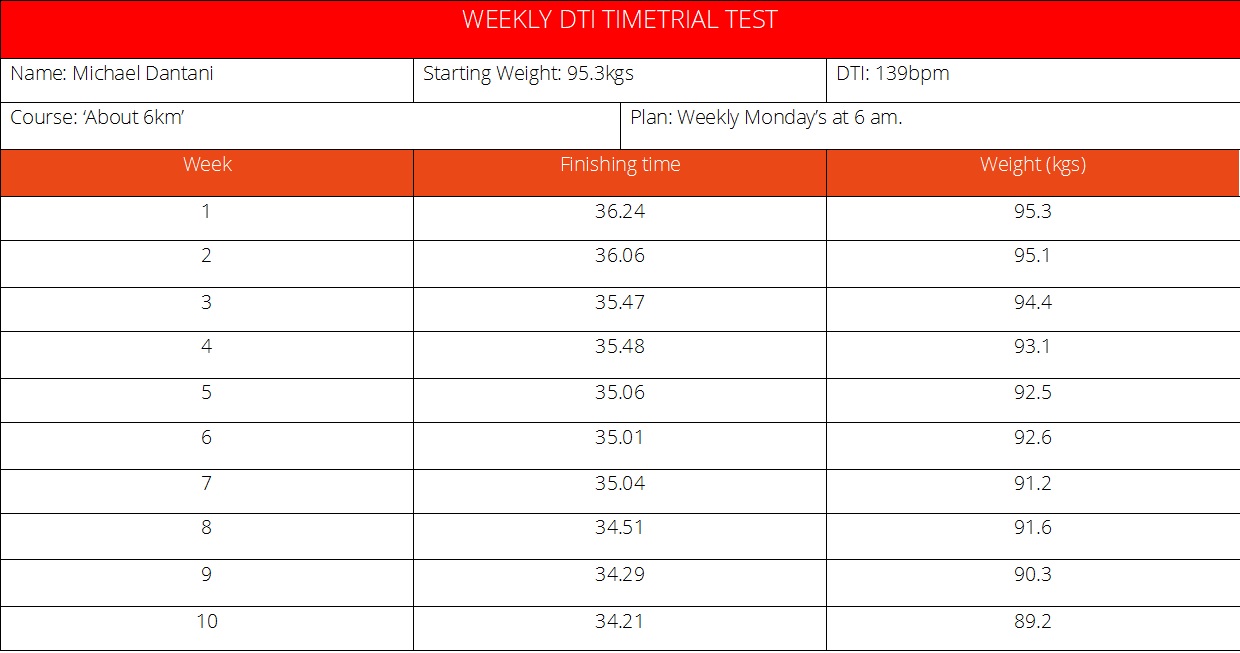-
Exercise, the 'right' way!
Re-entry into regular healthy exercise!
Practicing Brad Pamp's 'DTI Exercise Model'
START HERE
-
How it Works!
STEP 1 - Complete the online Questionnaire - ☑ remain ticked for 36 days/ on your platform.
STEP 2 - Flick through the reasoning behind the BP DTI Exercise Model.
STEP 3 - Be certain to calculate your DTI (Default Training Intensity).
STEP 4 - Design your DTI Timetrial Test (DTI TT).
STEP 5 - Open & print your Program - record your commitment.
STEP 6 - Day 35: 1) Re-assess the Fitness Status Questionnaire (unticking where possible), 2) Assess the 'I am Now' Questionnaire (10/10 is best), and 3) Perform your final DTI TT (a 8+% improvement is fantastic).
That's it!
-
Types: Anything rhythmic & continuous in nature at your conversational all-day perceived effort.
e.g. Walking, Running, Treadmill, Cycling, Rowing, Swimming, X-trainer.
Fibres used: red-iron-containing cells and loaded with blood vessels.
Perceived effort: about 'your' 6-7/10 effort related to your maximum sustained effort for 30 minutes, being 'your' 10/10.
Emotions: this is comfortable, sustainable, and for most, enjoyable.
Breathing: possible through the nose, comfortable, and rhythmic.
On finishing: 'I could keep going'
Metabolised fuel: Primarily the breakdown of stored sub-cutaneous 'fat'.
-
Types: Mostly interval-style action, reaching near your top end effort, briefly, then returning to an easy effort. Fitter people can sustain their higher end for longer.
e.g. Speed training, Spin classes, Boot Camps, Circuits, Resistance training.
Fibres used: white cells (fast-twitch) limited in blood vessels.
Perceived effort: about 'your' 8.5-10/10 effort related to your maximum sustained effort for 5 minutes, being 'your' 10/10.
Emotions: uncomfortable, somewhat painful feeling, and thankful to back off.
Breathing: all through the mouth, usually shorter faster breath volume.
On finishing: 'Thank heavens that's over'
Metabolised fuel: Totally blood glucose/ sugar.
-
1. Calculate 'your' optimum training intensity zone [DTI] - see below.
2. Understand your perception of effort at your DTI (HR Monitor's are best).
3. Select an activity allowing for rhythm and consistency.
4. Spend 3-5 minutes slowly building up to your DTI zone.
5. Spend the next 90% of total session time in your DTI zone.
6. Spend 1-2 minutes actively lowering your intensity back to rest.
7. Repeat this session 3-7/7 - 5/52.
8. Perform and record the DTI TT (Timetrial) once a week - see below.
-
Exercise is physical activity done for its own sake, either during the workout or immediately after it's through. ... In this context, Training is physical activity performed for the purpose of satisfying a long-term performance goal, and is therefore about the process instead of the workouts themselves.
If you're with me, we're training!
Lifestyle Analysis Method (LAM)
What you need: An honest sense of your lifestyle & current health.
Purpose: Determine your Default Training Intensity (DTI) represented in Heart Rate Beats per Minute.
Questions
a) 183 minus your Age = (This is your Heart Rate in Beats per Minute)
b) If you've suffered major illness within the last five years; minus 6 =
c) You've been largely sedentary over the past two years; minus 3 =
d) You have suffered more than one cold & flu over the past 12 months; minus 2 =
e) You are challenged regularly with muscle or joint inflammatory conditions; minus 3 =
f) You know you're currently challenged with lifestyle stress; minus 3 =
g) You've been largely healthy for two years; add 5 =
h) You've exercised regularly for three years; add 3 = (This number, your HR, is your DTI)
What is your DTI, in heart rate beats per minute? This is your training ceiling! You will not exceed this number for the next 35 days!
Your DTI Zone: From 10 beats lower than your DTI up to your DTI. Eg. 122-132bpm. Other than the first & last 5% of every session is spent in this pocket.
How your DTI should feel!
⦾ You can talk, easily, when training.
⦾ Your [good] form is never challenged.
⦾ Your breathing is even and controlled.
⦾ Zero pain, & zero muscle (lactic) burn.
⦾ You could work harder if required.
Post DTI workout feeling!
⦾ Knowing you could keep going.
⦾ Low, sugar, and, or, alcohol cravings.
⦾ You sleep soundly.
⦾ Loaded with sustained lifestyle energy.
⦾ You're more tolerant & interested.
Signs it's working?
⦾ Your ideal food choices appeal.
⦾ Your ideal weight is looming.
⦾ You're moving faster at your DTI.
⦾ You're free from injury & illness.
⦾ You're psyched for your next session.
Typically you'll experience the following
⁍ You'll feel your DTI is too easy.
⁍ In weeks 1-3, you'll feel somewhat frustrated with your reduced output, e.g. slower running speed.
⁍ You'll re-assess your DTI calculation beleiving you've calculated incorrectly - you haven't.
⁍ You'll think this model isn't working.
⁍ You may be bored.
⁍ You may might lose weight until week 3.
 If you're a returning trainer or new to the world of regular training and recognise your current health status could do with a reboot, I've listed below, 1) What the BP DTI Training Model will offer you, and 2) why it is ideal for you, now!
If you're a returning trainer or new to the world of regular training and recognise your current health status could do with a reboot, I've listed below, 1) What the BP DTI Training Model will offer you, and 2) why it is ideal for you, now!
BP DTI Training Model (Building your Aerobic Efficiency) will;
1) Influence your mindset towards selecting the right matching foods for you!
- Hunger 'trigger' hormones, ghrelin & leptin, are counter-balanced with DTI training. Meaning, DTI exercise helps change your behaviour - particularly towards better food choices.
2) Lower your collective inflammation, and strengthen your immune health.
- From gut-biome health to muscle & joint niggles, DTI boost healthy circulation free from higher acidic producing movement.
3) *Train your metabolism (energy production) to favour your stored fat as it's the primary fuel source.
- When practising DTI training, recovering, and while resting, by favouring stored 'fat' for energy, opposed to blood and stored sugar, will be lead towards your best weight & shape, naturally, free from stress. FOr most people, this is the pimary reason you should commit to the BP DTI Training Model. You are turning your metabolism into a fat-burning machine, for life. How you intake, transport & ultilise precise oxygen ia KING.
4) Leave your mindset balanced all day - yep, preventing stress influence your best performance, both at work and at home.
- DTI amps up feel-good hormones & neurotransmitters, like; endorphins, dopamine, & serotonin.
5) Influence your best 5-phase sleep.
- Balance your optimum serotonin/ melatonin switch.
I've listed the Top 5 outcomes you can expect should you push over your DTI before your aerobic system has sufficiently built up tolerance!
1) You'll be drawn towards pick-me-up foods, usually sugar-laden chooses.
DTI training favours your 'sugar' energy tank. This will require re-filling later in the day. Enter; your brain triggering insulin spiking (craved) chooses. These sub-optimal choices are working against building your aerobic capacity.
2) While perhaps not immediately, it's most likely you'll experience joint & muscle niggles through to an injury.
The higher (lactic) acidity response from >DTI work lowers your pH. 'Old' injuries will likely resurface and new ones appear. This is a seroius motivation killer to your goals. Oh, and if injury doesn't halt your progress, 9/10 will fall to an upper repsiratory illness. Again colds & the flu will often require 3-10 days recovery. Arrrh!
3) Yes, you'll burn (metabolise) more energy during the session, but, you'll be tapping into the wrong (energy) tank.
DTI training drives 1) energy being drawn from your fat tank, not your short-lived sugar tank, 2) You'll continue to draw 'more' energy from your fat reserves for the rest of the day.
4) You may feel great for about 90 minutes post-workout, but, then, you'll be mentally, emotionally and physically tired, flat, lethargic for the rest of the day.
>DTI action will result in tiredness, lower your tolerance, interest and communicative energy - this is not good. Lifetyle stress throws out more than enough stress induced hormones like; adrenalin, non-adrenalin and cortisol. The last thing we need, now, is our exercise session thumping up further stress hormones. Unbalanced stress on stress should be avoided.
5) Overstimulated nerves & higher body temperature will rarely lead to quality sleep - beware.
Ideally, I recommend morning or lunchtime exercise. Your body will sleep best free from sparked-up nerves and once your body has cooled post exercise.
NOTE - I'm not suggesting you avoid >DTI training forever. Far from it. >DTI training, particulalry resistance training, offers up significant health benefits, but, NOT, before your aerobic system has been sufficiently build. You're building towards a point of >DTI tolerance.
-
⦾ Choose your 'main' and tested activity (walk, ride, run, row etc),
⦾ Make certain it's repeatable, logistically possible & excuse free,
⦾ Your DTI TT activity is your main activity for the 35 days.
⦾ Yes, mix up your training activities, but your DTT TT choice = 75%+.
⦾ Choose an activity you can hold DTI for 30-50 minutes, non-stop.
⦾ You can choose indoor or outdoor training.
⦾ Electronic choices must offer measuring data; e.g. time, distance.
⦾ Mornings are usually better, but not always.
⦾ The more consistent your activity the better.
-
⦾ DTI Training works best practising with a Heart Rate Monitor.
⦾ HRM's offer repeatable accuracy.
⦾ Sessions can be recorded & saved.
⦾ Policing your DTI is easy.
⦾ You can even program a DTI alarm.
⦾ I favour Garmin or Polar chest strap options FYI.
⦾ You can always pick up bargains on eBay.
⦾ Ultimately, all you need is HR & stopwatch.
⦾ Youtube is littered with help guides.
-
⦾ Firstly, your DTI Training componant is your #1 priority.
⦾ However, a small dose of resistance work compliments perfectly.
⦾ You'll need a pair of dumbbells, only.
⦾ You'll be performing 3+/7 sessions, about 6-minutes a session.
⦾ You'll need to determine your perfect DB set weight.
⦾ DB Test - Shoulder Press (pic) 3 x 10 (20-sec rest). 10's are good.
⦾ There are 5 exercises in your post strength set/ post DTI.
⦾ Most fitness/sports stores will sell (cheap) DB's.
⦾ Your DB's will outlive you.
WATCH FIRST!
Your Timetrial Test
Why?
- Confirm your improving fitness and running talent
- Drive ongoing motivation
- Highlight training and health troubleshooting
- Results dictate future training plans
What!
An outside testing course;
- Design a flattish, uniteruppted course over even and safe terrain.
- An out and back course often works best.
- Define the exact start & finish of your course.
- Your course must be repeatable, week to week.
- The distance is irrelevant, so a GPS is not required but can offer useful data (changes in pace; namely, are you finishing the second half as strongly as you went out).
- Your course should have you finish your first test between 30-50 minutes. (E.g 35.45).
- You are racing your course, HOWEVER, you are never allowed to exceed your DTI limit (E.g 141 bpm).
- Remember, whether walking or running, you are racing (yourself).
E.g. An inside testing choice;
- Treadmill – Fix the gradient on 1%, hold your DTI, and stop the stopwatch when you reach e.g. 5km, or, alternatively, record your distance after 35 minutes e.g. 4.7km.
- Remember your ‘improving’ goal will be to either complete 5km faster or cover a greater distance in 35 minutes.
How
- Turn on your heart rate monitor – chest straps are the most accurate and reliable.
- Ideally, program your HRM to alarm (beep or vibrate) should you exceed your DTI.
- Warm-up for 2-5 minutes.
- Start your stopwatch at the designated starting area.
- Rev up your effort to your HR ceiling as soon as possible.
- Back off your speed if you exceed your DTI.
- Stop your stopwatch at the designated finish line.
- Record your result.
The following should transpire;
✔ You produce more output at the same intensity - e.g. you finish your test course faster at the same DTI.
✔ If it be necessary, and it is for most, you'll start to lose unnecessary body fat.
✔ Chronic on chronic annoying niggles will 'disappear.
✔ Your training temperature will lower.
✔ You'll look forward to your next DTI TT.
FYI - An example of the DTI TT in action.
Varying Results
Don't be too disappointed if you don't nail a personal best every week! Week 5, Day 35, is your most important  testing day.
testing day.
Take note, the following can influence your week to week results - more so - increasing your heart rate for various reasons.
◦ Increase in temperature.
◦ Running against the wind.
◦ Increases lifestyle stress.
◦ Testing at a different time of day.
◦ Looming illness.
◦ Gut dysfunction, a result from poor food choices.
◦ Poor sleep.
◦ Overtraining.
-
Keeping it Simple
✔ Train, daily, as often as life allows.
🏳 DTI training doesn't require rest days!
✔ Keep sessions between 30-50 minutes, total.
✔ Perform & record your weekly DTI TT.
✔ Your DTI TT activity, e.g. running, makes up 75% of total DTI time.
✔ Post DTI training, complete your 'short' strength set.
✔ Open, Print, & Record your training.
💪 Mapping out & diarising your weekly sessions is key.
💪 As much of the training offers little variety, MUSIC can be KING!
💪 Other than your TT, mix up your courses and activity choice.
💪 Re-read the benefits you'll experience post 35 days.
💪 If you're training indoors, consider visual stimulation; youtube, Netflix etc.
💪 Buy new shoes - consider the HOKA brand.
💪 Play unofficial TT games everyday! Race your best performance (holding your DTI).
💪 Be certain to match fitting food choices.
💪 Harden up - it's a 35 day project.




